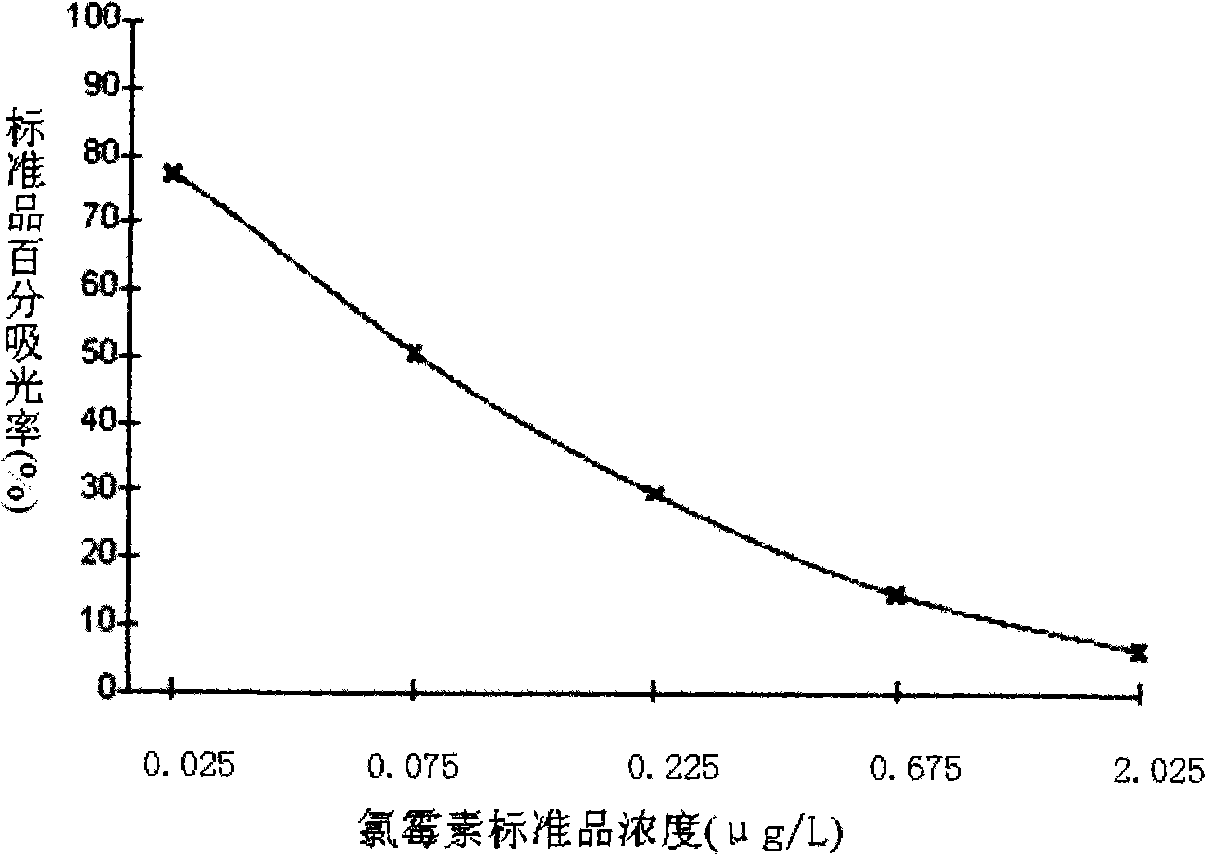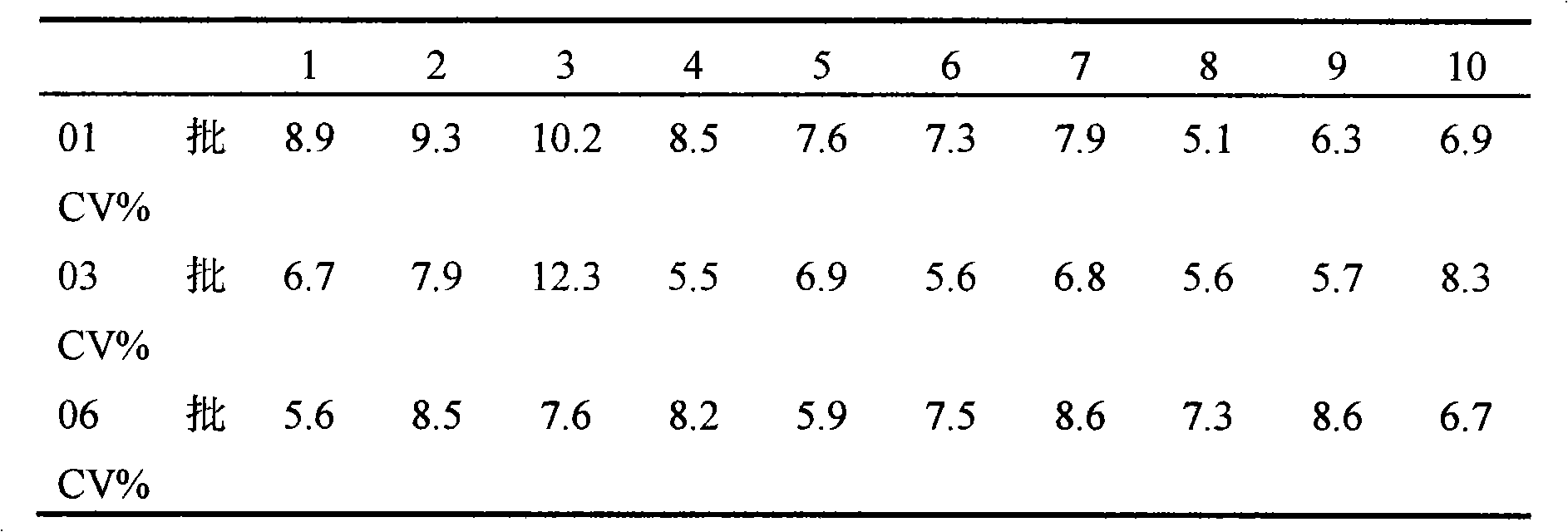Elisa reagent for detecting chloramphenicol and method thereof
An enzyme-linked immunosorbent reagent, chloramphenicol technology, applied in biological testing, measuring devices, material testing products, etc., can solve the problems of chloramphenicol toxicity, premature gray syndrome, granular leukocyte deficiency and other problems
- Summary
- Abstract
- Description
- Claims
- Application Information
AI Technical Summary
Problems solved by technology
Method used
Image
Examples
Embodiment 1
[0150] Embodiment 1 detects the preparation of the ELISA kit component of chloramphenicol
[0151] 1. Antigen Synthesis
[0152] a. Synthesis of Coating Progen
[0153] The chloramphenicol hapten is synthesized by a derivative method, and then the hapten is obtained by coupling the hapten with a bovine gamma globulin carrier protein by an active ester method through a diazotization reaction.
[0154] b. Synthesis of Immunogen
[0155] The hapten of chloramphenicol is obtained by coupling the hapten of chloramphenicol with the carrier protein of keyhole limpet hemocyanin by the active ester method.
[0156] 2. Preparation of Chloramphenicol Mouse Monoclonal Antibody
[0157] a. Animal immunity
[0158] Balb / c mice were used as immunized animals, the chloramphenicol hapten and keyhole limpet hemocyanin conjugate was used as the immunogen, the immunization dose was 300 μg / mouse, and the immunogen was mixed with the same amount of Freund's complete The adjuvant was mixed to m...
Embodiment 2
[0169] Embodiment 2 detects the formation of the ELISA kit of chloramphenicol
[0170] Set up the ELISA kit for detecting chloramphenicol so that it includes the following components:
[0171] (1) enzyme-linked plate coated with chloramphenicol antigen;
[0172] (2) Goat anti-mouse anti-antibody labeled with horseradish peroxidase;
[0173] (3) Chloramphenicol mouse monoclonal antibody;
[0174] (4) 6 bottles of chloramphenicol standard solution, the concentrations are 0 μg / L, 0.025 μg / L, 0.075 μg / L, 0.225 μg / L, 0.675 μg / L, 2.025 μg / L;
[0175] (5) The substrate chromogenic solution is a mixed solution of hydrogen peroxide or carbamide peroxide and o-phenylenediamine (OPD) or tetramethylbenzidine (TMB);
[0176] (6) The stop solution is 2mol / L sulfuric acid buffer;
[0177] (7) The concentrated washing solution is deionized water or triple distilled water;
[0178] (8) Antibody diluent is pH 8.2, 0.05 mol / L, phosphate buffer containing 3% horse serum and 5‰ gelatin.
[0...
Embodiment 3
[0180] Embodiment 3 detects the formation of the ELISA kit of chloramphenicol
[0181] Set up the ELISA kit for detecting chloramphenicol so that it includes the following components:
[0182] (1) Enzyme-linked plate coated with goat anti-rabbit anti-antibody;
[0183] (2) chloramphenicol antigen labeled with alkaline phosphatase;
[0184] (3) Chloramphenicol rabbit polyclonal antibody;
[0185](4) 6 bottles of chloramphenicol standard solution, the concentrations are 0 μg / L, 0.025 μg / L, 0.075 μg / L, 0.225 μg / L, 0.675 μg / L, 2.025 μg / L;
[0186] (5) Substrate chromogenic solution p-nitrophosphate buffer;
[0187] (6) The stop solution is 2mol / L sodium hydroxide buffer solution;
[0188] (7) Concentrated washing liquid deionized water or triple distilled water;
[0189] (8) The concentrated complex solution is deionized water or triple distilled water.
PUM
 Login to View More
Login to View More Abstract
Description
Claims
Application Information
 Login to View More
Login to View More - R&D
- Intellectual Property
- Life Sciences
- Materials
- Tech Scout
- Unparalleled Data Quality
- Higher Quality Content
- 60% Fewer Hallucinations
Browse by: Latest US Patents, China's latest patents, Technical Efficacy Thesaurus, Application Domain, Technology Topic, Popular Technical Reports.
© 2025 PatSnap. All rights reserved.Legal|Privacy policy|Modern Slavery Act Transparency Statement|Sitemap|About US| Contact US: help@patsnap.com



